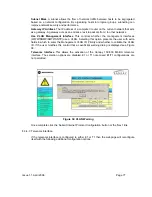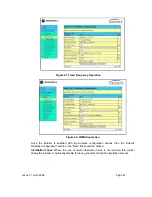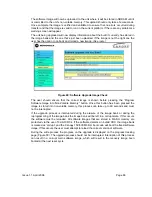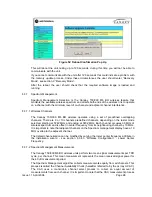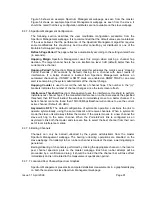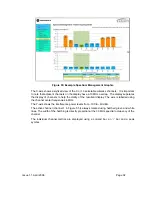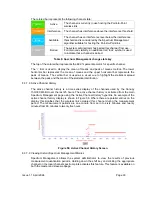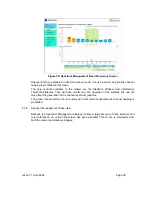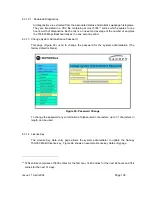
Issue 1.1 April 2006
Page 91
Figure 53
shows an example Spectrum Management webpage as seen from the master.
shows an example Spectrum Management webpage as seen from the slave. It
should be noted that the key configuration attributes are not available on the slave webpage.
8.3.7.5 Spectrum Management Configuration
The following section describes the user modifiable configuration accessible from the
Spectrum Management webpage. It is recommended that the default values are maintained.
If the user believes that the performance of the Spectrum Management algorithm requires
some modifications this should only be done after consulting your distributor or one of the
Motorola field support engineers.
Refresh Page Period
The page refreshes automatically according to the setting entered here
(in seconds).
Hopping Margin
Spectrum Management uses this margin when making a channel hop
decision. The target channel has to have an interference level 3 dB (default) better than the
current active channel.
Hopping Period
The Spectrum Management algorithm evaluates the metrics every ‘Hopping
Period’ seconds (180 seconds by default) looking for a channel with lower levels of
interference. If a better channel is located then Spectrum Management performs an
automated channel hop. If SNMP or SMTP alerts are enabled an SNMP TRAP or an email
alert is sent warning the system administrator of the channel change.
Hopping Counter
is used to record the number of channel hops. The number in the “(+)”
brackets indicates the number of channel changes since the last screen refresh.
Interference Threshold
Spectrum Management uses the interference threshold to perform
instantaneous channel hops. If the measured interference on a channel exceeds the specified
threshold, then iDFS will instruct the wireless to immediately move to a better channel. If a
better channel cannot be found then 150/300 Mbps Backhaul will continue to use the current
active channel. (Default –85 dBm)
Asymmetric DFS
The default configuration of symmetric operation, constrains the link to
operate symmetrically, using the same transmit and receive channels. When in symmetric
mode the slave unit will always follow the master. If the master moves to a new channel the
slave will hop to the same channel. When the Point-to-Point link is configured as an
asymmetric link both the master and slave are free to select the best channel from their own
set of local interference metrics.
8.3.7.6 Barring Channels
Channels can only be barred / unbarred by the system administrator from the master
Spectrum Management webpage. The barring / unbarring operations are disabled on the
slave webpage. If an attempt to bar / unbar a channel is made at the slave a warning dialog is
generated.
Barring/Unbarring of channels is performed by clicking the appropriate channel on the local or
peer channel spectrum plots on the master webpage. Each bar / unbar attempt will be
proceeded by a confirmation dialog. It should be noted that the channel bar will take effect
immediately and is not related to the measurement quantization period.
8.3.7.7 Local and Peer Channel Spectrum Graphics
Spectrum Management presents its computed statistical measurements in a graphical display
on both the master and slave Spectrum Management webpage.
Содержание Canopy 150 Mbps Backhaul
Страница 1: ...Canopy 150 300 Mbps Backhaul User Guide BH150 300 UG en Issue 1 1 April 2006 ...
Страница 25: ...Issue 1 1 April 2006 Page 24 Figure 5 Canopy 150 300 PIDU Power Input ...
Страница 66: ...Issue 1 1 April 2006 Page 65 Figure 29 Save and Restore Configuration Page Figure 30 Save File Pop up ...
Страница 97: ...Issue 1 1 April 2006 Page 96 Figure 59 Spectrum Management Help Page ...
Страница 162: ...Issue 1 1 April 2006 Page 161 Figure A8 Surge Arrestor ALPU ORT Connection Illustration ...
Страница 167: ...Issue 1 1 April 2006 Page 166 Figure 113 64 QAM 0 92 Dual Payload Figure 114 256 QAM 0 81 Dual Payload ...

